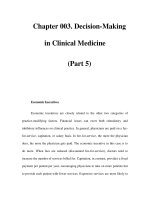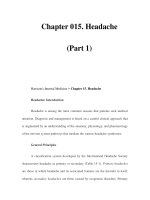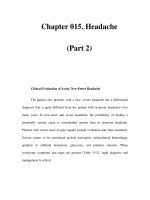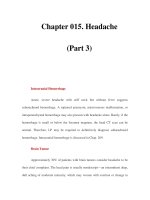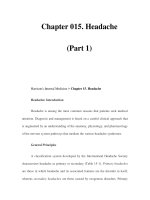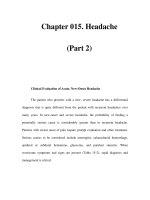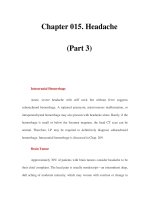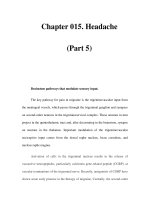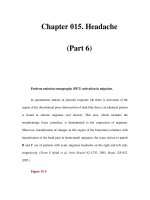Chapter 015. Headache (Part 5) ppt
Bạn đang xem bản rút gọn của tài liệu. Xem và tải ngay bản đầy đủ của tài liệu tại đây (76.54 KB, 5 trang )
Chapter 015. Headache
(Part 5)
Brainstem pathways that modulate sensory input.
The key pathway for pain in migraine is the trigeminovascular input from
the meningeal vessels, which passes through the trigeminal ganglion and synapses
on second-order neurons in the trigeminocervical complex. These neurons in turn
project in the quintothalamic tract and, after decussating in the brainstem, synapse
on neurons in the thalamus. Important modulation of the trigeminovascular
nociceptive input comes from the dorsal raphe nucleus, locus coeruleus, and
nucleus raphe magnus.
Activation of cells in the trigeminal nucleus results in the release of
vasoactive neuropeptides, particularly calcitonin gene-related peptide (CGRP), at
vascular terminations of the trigeminal nerve. Recently, antagonists of CGRP have
shown some early promise in the therapy of migraine. Centrally, the second-order
trigeminal neurons cross the midline and project to ventrobasal and posterior
nuclei of the thalamus for further processing. Additionally, there are projections to
the periaqueductal gray and hypothalamus, from which reciprocal descending
systems have established anti-nociceptive effects. Other brainstem regions likely
to be involved in descending modulation of trigeminal pain include the nucleus
locus coeruleus in the pons and the rostroventromedial medulla.
Pharmacologic and other data point to the involvement of the
neurotransmitter 5-hydroxytryptamine (5-HT; also known as serotonin) in
migraine. Approximately 50 years ago, methysergide was found to antagonize
certain peripheral actions of 5-HT and was introduced as the first drug capable of
preventing migraine attacks. The triptans are designed to selectively stimulate
subpopulations of 5-HT receptors; at least 14 different 5-HT receptors exist in
humans. The triptans are potent agonists of 5-HT
1B
, 5-HT
1D
, and 5-HT
1F
receptors
and are less potent at the 5-HT
1A
receptor. A growing body of data indicates that
the antimigraine efficacy of the triptans relates to their ability to stimulate 5-
HT
1B/1D
receptors, which are located on both blood vessels and nerve terminals.
Data also support a role for dopamine in the pathophysiology of certain
subtypes of migraine. Most migraine symptoms can be induced by dopaminergic
stimulation. Moreover, there is dopamine receptor hypersensitivity in migraineurs,
as demonstrated by the induction of yawning, nausea, vomiting, hypotension, and
other symptoms of a migraine attack by dopaminergic agonists at doses that do not
affect nonmigraineurs. Dopamine receptor antagonists are effective therapeutic
agents in migraine, especially when given parenterally or concurrently with other
antimigraine agents.
Migraine genes identified by studying families with familial hemiplegic
migraine (FHM) reveal involvement of ion channels, suggesting that alterations in
membrane excitability can predispose to migraine. Mutations involving the Ca
v
2.1
(P/Q) type voltage-gated calcium channel CACNA1A gene are now known to
cause FHM 1; this mutation is responsible for about 50% of FHM. Mutations in
the Na
+
-K
+
ATPase ATP1A2 gene, designated FHM 2, are responsible for about
20% of FHM. Mutations in the neuronal voltage-gated sodium channel SCN1A
cause FHM 3. Functional neuroimaging has suggested that brainstem regions in
migraine (Fig. 15-2) and the posterior hypothalamic gray matter region close to
the human circadian pacemaker cells of the suprachiasmatic nucleus in cluster
headache (Fig. 15-3) are good candidates for specific involvement in primary
headache.
